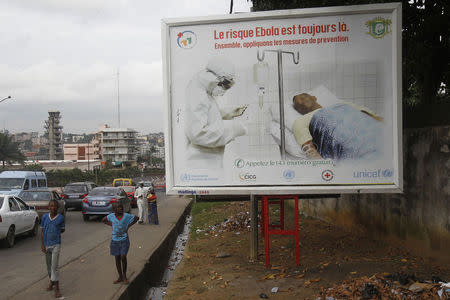Ebola poses threat to Ivory Coast cocoa output, exporters say
By Joe Bavier ABIDJAN (Reuters) - Cocoa exporters in the Ivory Coast are fuelling market fears of potential supply shortages that have driven prices to 3-1/2 year highs, warning output could drop dramatically if the Ebola virus spills into the world's top grower. Despite expectations of a supply surplus this season and a healthy outlook for the coming West African harvest, prices are reflecting the fact that much is unknown about what happens if Ivory Coast is the next country struck by the disease. Late last week, the World Health Organisation (WHO) said the death toll from an outbreak of Ebola in West Africa had topped 3,000. Exporters say even a few isolated cases along the 1,000 km (640 mile) border with Liberia and Guinea, which are already struggling to control the epidemic, would disrupt the flow of beans. "It's a long border. It's vulnerable and hard to control," said the purchases manager for an exporter in the port city of Abidjan, the economic capital. "It's a serious threat." Ivory Coast produced some 1.45 million tonnes of cocoa last season, nearly two-fifths of the world's supply of around 4 million tonnes, according to the International Cocoa Organisation. It is on track to produce a record crop for the 2013/14 season, which ends this week. "Right now is the most sensitive time for an awful lot of people in the market," Jonathan Parkman, joint head of agriculture at broker Marex Spectron, told Reuters. "The reason for that is they've got a huge amount of cocoa contracted for shipment in the next few months from Ivory Coast ... plus the market is at new highs, therefore margin stress is at its peak." A MILLION TONNES AT RISK? Liberia's Maryland and Grand Kru counties, near the border with Ivory Coast, recorded their first cases of Ebola in the past two weeks, according to WHO. The bulk of Ivory Coast's cocoa is harvested from November to January and the size of losses would depend upon when cases were identified. Another exporter estimated a border quarantine could lead to around 75,000 tonnes of lost production. "If the whole west is hit, that's 600,000 tonnes. With San Pedro and Sassandra included, you're talking about a million tonnes," said a San Pedro-based exporter. "It would be catastrophic." When cocoa last touched such high levels in April 2011, Ivory Coast was approaching the end of a post-election civil war. Despite the conflict, the country harvested a record crop as beans that were initially held up by the violence were eventually shipped. Exporters worry however that might not happen if Ebola were to strike. "What we fear is that under a quarantine nothing will move, that farmers will flee, that trucks won't go in and that the cocoa will rot on the trees," another exporter said. But fears of a million tonnes of cocoa supply being put at risk appear overblown as Ivory Coast is taking aggressive anti-infection measures that its poorer western neighbours were slow to adopt. The government action taken so far, including closure of the western border and patrols by the army, has raised expectations the government will seal off any area touched by the disease in order to prevent its spread. Officials were not immediately available for comment on any possible contingency plans for Ebola, but most exporters contacted by Reuters said they expected a rapid response from the government that would avoid a major outbreak. Nigeria and Senegal, which like Ivory Coast possess better equipped health sectors than other Ebola-hit countries, succeeded in quickly containing outbreaks of the disease, raising hopes any epidemic could be quickly stopped. After a slow initial response by the international community, money and equipment are now pouring into West Africa. The United States and Britain are both deploying military personnel to the region to help combat the epidemic. "There are 3,000 (U.S.) troops now moving into Liberia. The world is now serious about containing the outbreak within a restricted space," said a fourth exporter. "I think the most likely scenario is that there will be two or three cases." (Additional reporting by Sarah McFarlane in London; Editing by Daniel Flynn, Veronica Brown and David Evans)



